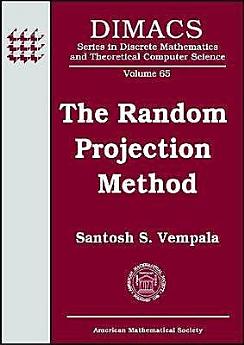The Random Projection Method
Santosh S. Vempala
ก.พ. 2005 · DIMACS Series หนังสือเล่มที่ 65 · American Mathematical Soc.
eBook
105
หน้า
reportคะแนนและรีวิวไม่ได้รับการตรวจสอบยืนยัน ดูข้อมูลเพิ่มเติม
เกี่ยวกับ eBook เล่มนี้
Random projection is a simple geometric technique for reducing the dimensionality of a set of points in Euclidean space while preserving pairwise distances approximately. The technique plays a key role in several breakthrough developments in the field of algorithms. In other cases, it provides elegant alternative proofs. The book begins with an elementary description of the technique and its basic properties. Then it develops the method in the context of applications, which are divided into three groups. The first group consists of combinatorial optimization problems such as maxcut, graph coloring, minimum multicut, graph bandwidth and VLSI layout. Presented in this context is the theory of Euclidean embeddings of graphs. The next group is machine learning problems, specifically, learning intersections of halfspaces and learning large margin hypotheses. The projection method is further refined for the latter application. The last set consists of problems inspired by information retrieval, namely, nearest neighbor search, geometric clustering and efficient low-rank approximation. Motivated by the first two applications, an extension of random projection to the hypercube is developed here. Throughout the book, random projection is used as a way to understand, simplify and connect progress on these important and seemingly unrelated problems. The book is suitable for graduate students and research mathematicians interested in computational geometry.
ให้คะแนน eBook นี้
แสดงความเห็นของคุณให้เรารับรู้
ข้อมูลในการอ่าน
สมาร์ทโฟนและแท็บเล็ต
ติดตั้งแอป Google Play Books สำหรับ Android และ iPad/iPhone แอปจะซิงค์โดยอัตโนมัติกับบัญชีของคุณ และช่วยให้คุณอ่านแบบออนไลน์หรือออฟไลน์ได้ทุกที่
แล็ปท็อปและคอมพิวเตอร์
คุณฟังหนังสือเสียงที่ซื้อจาก Google Play โดยใช้เว็บเบราว์เซอร์ในคอมพิวเตอร์ได้
eReader และอุปกรณ์อื่นๆ
หากต้องการอ่านบนอุปกรณ์ e-ink เช่น Kobo eReader คุณจะต้องดาวน์โหลดและโอนไฟล์ไปยังอุปกรณ์ของคุณ โปรดทำตามวิธีการอย่างละเอียดในศูนย์ช่วยเหลือเพื่อโอนไฟล์ไปยัง eReader ที่รองรับ








